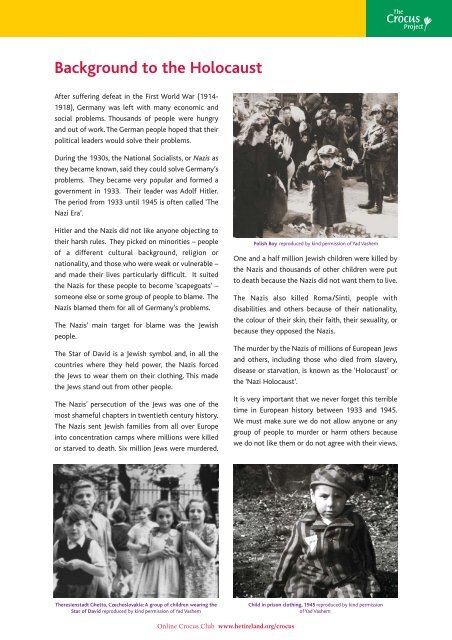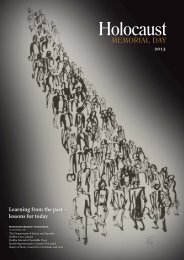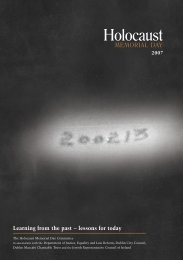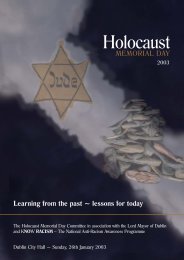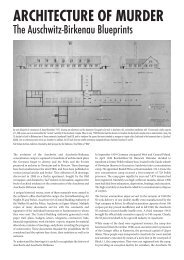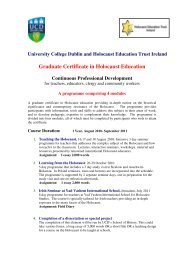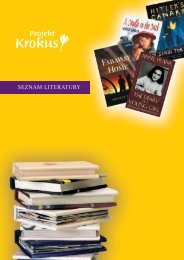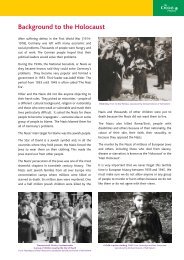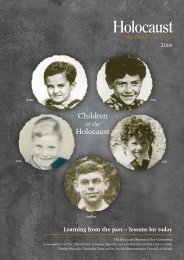15321c Crocus posters:1 - Holocaust Education Trust of Ireland
15321c Crocus posters:1 - Holocaust Education Trust of Ireland
15321c Crocus posters:1 - Holocaust Education Trust of Ireland
Create successful ePaper yourself
Turn your PDF publications into a flip-book with our unique Google optimized e-Paper software.
The <strong>Crocus</strong> Project – A guide for teachersBackground to the <strong>Holocaust</strong>After suffering defeat in the First World War (1914-1918), Germany was left with many economic andsocial problems. Thousands <strong>of</strong> people were hungryand out <strong>of</strong> work. The German people hoped that theirpolitical leaders would solve their problems.During the 1930s, the National Socialists, or Nazis asthey became known, said they could solve Germany’sproblems. They became very popular and formed agovernment in 1933. Their leader was Adolf Hitler.The period from 1933 until 1945 is <strong>of</strong>ten called ‘TheNazi Era’.Hitler and the Nazis did not like anyone objecting totheir harsh rules. They picked on minorities – people<strong>of</strong> a different cultural background, religion ornationality, and those who were weak or vulnerable –and made their lives particularly difficult. It suitedthe Nazis for these people to become ‘scapegoats’ –someone else or some group <strong>of</strong> people to blame. TheNazis blamed them for all <strong>of</strong> Germany’s problems.The Nazis’ main target for blame was the Jewishpeople.The Star <strong>of</strong> David is a Jewish symbol and, in all thecountries where they held power, the Nazis forcedthe Jews to wear them on their clothing. This madethe Jews stand out from other people.The Nazis’ persecution <strong>of</strong> the Jews was one <strong>of</strong> themost shameful chapters in twentieth century history.The Nazis sent Jewish families from all over Europeinto concentration camps where millions were killedor starved to death. Six million Jews were murdered.Polish Boy reproduced by kind permission <strong>of</strong> Yad VashemOne and a half million Jewish children were killed bythe Nazis and thousands <strong>of</strong> other children were putto death because the Nazis did not want them to live.The Nazis also killed Roma/Sinti, people withdisabilities and others because <strong>of</strong> their nationality,the colour <strong>of</strong> their skin, their faith, their sexuality, orbecause they opposed the Nazis.The murder by the Nazis <strong>of</strong> millions <strong>of</strong> European Jewsand others, including those who died from slavery,disease or starvation, is known as the ‘<strong>Holocaust</strong>’ orthe ‘Nazi <strong>Holocaust</strong>’.It is very important that we never forget this terribletime in European history between 1933 and 1945.We must make sure we do not allow anyone or anygroup <strong>of</strong> people to murder or harm others becausewe do not like them or do not agree with their views.Theresienstadt Ghetto, Czechoslovakia: A group <strong>of</strong> children wearing theStar <strong>of</strong> David reproduced by kind permission <strong>of</strong> Yad VashemChild in prison clothing, 1945 reproduced by kind permission<strong>of</strong> Yad VashemOnline <strong>Crocus</strong> Club www.hetireland.org/crocus
The <strong>Crocus</strong> Project – A guide for teachersAn t-Uileloscadh – CúlraTar éis an Chéad Chogadh Domhanda (1914-1918) achailliúint bhí a lán fadhbanna sóisialacha aguseacnamaíochta ag an nGearmáin. Bhí ocras ar namílte agus fágadh iad dífhostaithe. Bhí súil ag naGearmánaigh go mbeadh na ceannairí polaitiúla inann a gcuid fadhbanna a réiteach.I rith na 1930í, duirt an Páirtí Sóisialach Náisiúnta, nóna Naitsithe mar a tugadh orthu, go mbeadh siad inann fadhbanna na Gearmáine a réiteach. Tháinig cáilmhór orthu agus bhunaigh siad rialtas i 1933. Ba éAdolf Hitler a gceannaire. Tugtar “Ré na Naitsithe” gominic ar an tréimhse idir 1933 agus 1945.Níor mhaith le Hitler agus a lucht leanúna daoine náraontaigh leo agus a gcuid rialacha. Roghnaigh siadroinnt grúpaí mionlacha – daoine ó chúlraí difriúla,iad siúd le creideamh éagsúil nó gur as náisiún eiledóibh – agus rinne siad leatrom orthu. Chaith siad godona ar fad le daoine laga, leochaileacha. Bhí séfeiliúnach do na Naitsithe ceap magaidh a dhéanamhde na mionlaigh seo go bhféadfaidís an milleániomlán a chur orthu d’fhadhbanna uile na Gearmáine.Ba iad na Giúdaigh go príomha a fuair drochíde ó naNaitsithe.Tír ar bith a bhí faoi smacht ag na Naitsithe, cuireadhiachall ar na Giúdaigh inti réalta mhór bhuí achaitheamh ar a gcuid éadaí. Is siombal lárnach í anréalta seo do na Giúdaigh. Rinne sé idirdhéalú idir iadagus daoine eile. Tugtar ‘Réalta Dháibhí’ ar an réalta seo.Bhi ciapadh na nGiúdach ar cheann de na himeachtaíba mhó náire sa fichiú aois.Sheol na Naitsithe teaghlaigh Giúdacha ar fud nahEorpa go sluachampaí géibhinn, áit ar maraíodh namilliúin muna bhfuair siad bás den ocras.Dúnmharaíodh sé mhilliún Giúdach. Mharaigh naBuachaill Polannach atáirgthe le caoinchead Yad Vashem.Naitsithe milliún go leith páiste Giúdach aguscuireadh na mílte páistí eile chun báis mar nár mhianleis na Naitsithe go mairfeadh siad.Chomh maith leis sin, mharaigh na NaitsitheRoma/Sinti, daoine le míchumas agus daoine eile margheall ar a náisiúnacht, dath a gcraicinn, agcreideamh, a ngnéasacht, nó de bhrí go raibh siad igcoinne na Naitsithe.Tugtar ‘an t-Uileloscadh’ nó ‘Uileloscadh na Naitsithe’ar dhúnmharú na milliúin Giúdach Eorpacha agus eilefaoi lámha na Naitsithe, ina measc na daoine a fuairbás mar gheall ar sclábhaíocht, ó ghalair nó den ocras.Tá sé rí-thábhachtach nach ndéanamid dearmad ar androch-thréimhse seo i stair na hEorpa idir 1933 and1945. Caithimid bheith ar an airdeall nach dtugtarcead d’éinne nó do ghrúpa ar leith daoine adhúnmharú nó a ghortú mar gheall nach dtaitníonnsiad linn nó nach n-aontaíonn siad lenár dtuairimí.Geiteo Theresienstadt, an tSeicslóvaic: Grúpa páistí ag caitheamh RéaltaDháibhí atáirgthe le caoinchead Yad Vashem.Páiste í gculaith priosúnaigh, 1945 atáirgthe le caoinchead Yad VashemOnline <strong>Crocus</strong> Club www.hetireland.org/crocus
3The <strong>Crocus</strong> Project – A guide for teachersWhy we plant yellow crocusesSadness and HopeWe plant yellow crocuses in memory <strong>of</strong> one and ahalf million Jewish children and thousands <strong>of</strong> otherchildren who died in the <strong>Holocaust</strong>. The yellowcolour <strong>of</strong> the flowers reminds us <strong>of</strong> the yellow starthe Jews had to wear under Nazi rule. The flowersremind us <strong>of</strong> all <strong>of</strong> the children who perished.Hundreds <strong>of</strong> thousands <strong>of</strong> children were murdered bythe Nazis, but many survived. The children whosurvived are mostly grandparents today. They havepassed on their stories to their children andgrandchildren. Their stories must never be forgotten.We must tell them to our own children.When the crocuses bloom at the beginning <strong>of</strong> spring,we remember the children who died. But thebeautiful flowers also remind us that, even after themost terrible events, new life begins again and we canhope that things will be better than they were before.The flowers remind us that there is still beauty in theworld and hope for our future. Planting the flowers issad, but it is hopeful too.Hanna Lethrer, Munichreproduced by kind permission <strong>of</strong>Yad Vashem<strong>Crocus</strong>es in bloom planted bypupils in Kilkenny School Project,Springfields, Kilkenny, <strong>Ireland</strong>Eventually we hope that children from all over theworld will plant yellow crocuses in memory <strong>of</strong> all <strong>of</strong>the children who died in the <strong>Holocaust</strong>.Jewish family in the Budapest ghetto, 1944 reproduced by kind permission <strong>of</strong> Yad VashemOnline <strong>Crocus</strong> Club www.hetireland.org/crocus
4An Tionscnamh Crócais – Treoir do mhúinteoiríAn chúis a churimid crócais bhuíBrón agus DóchasCuirimid crócais bhuí sa talamh i gcuimhne milliún goleith páiste Giúdach agus na mílte páiste eile a fuairbás san Uileloscadh. Cuireann dath buí nambláthanna seo i gcuimhne dúinn an réalt bhuí a bhíar na Giúdaigh a chaitheamh le linn rialú na Naitsithe.Meabhraíonn na bláthanna dúinn na páistí go léir afuair bás.Dhúnmharaigh na Naitsithe na céadta míle páiste,ach d’éirigh le go leor eile teacht slán. Tá formhór nabpáistí a tháinig slán ina seantuismitheoirí inniu.Roinn siad a gcuid scéalta lena bpáistí agus angarpháistí. Ní féidir dearmad a dhéanamh ar nascéalta seo. Caithimid iad a roinnt lenár bpáistí féin.Nuair a thagann na crócais faoi bhláth ag tús anearraigh, cuimhnimid ar na páistí a fuair bás. Fiú agusna heachtraí uafásacha seo tar éis titim amach,cuireann na bláthanna áille seo i gcuimhne dúinnfreisin go dtosnaíonn saol nua arís, agus is féidir linna bheith dóchasach go mbeidh cúrsaí níos fearr satodhchaí ná mar a bhí. Cuireann na bláthanna igcuimhne dúinn go bhfuil áilleacht fágtha sa domhanHanna Lethrer, Munich atáirgthe lecaoinchead Yad VashemCrócais faoi bhláth i ScoilTionscnamh Chill Chainnigh,Springfields, Cill Chainnighagus dóchas i ndán dúinn amach anseo. Tá plandáil nambláthanna brónach ach tá sé dóchasach freisin.Faoi dheireadh, tá súil againn go gcuirfidh páistí ar fudan domhain crócais bhuí i gcuimhne na bpáistí uile afuair bás i rith an Uileloiscthe.Clann Gúidach i nGeiteo Budapest, 1944 atáirgthe le caoinchead Yad VashemClub Crócais Ar Líne www.hetireland.org/crocus
Planting crocuses<strong>Crocus</strong> bulbs are planted in the autumn betweenmid-September and mid-November. Spring comes atdifferent times in different countries. It does notmatter too much when the flowers bloom: theimportant thing is that they are planted in memory<strong>of</strong> the children who died in the <strong>Holocaust</strong> and thatwhen the flowers appear, we are reminded aboutthem.<strong>Crocus</strong>es planted in the shape <strong>of</strong> a Star <strong>of</strong> David by pupils <strong>of</strong> St Martin'sPrimary School, Garrison, Co. Fermanagh, Northern <strong>Ireland</strong>GardenPlant crocus bulbs approximately 15cm deep ingood soil. Water and leave until the flowersbegin to pop up in the spring.You may wish to mark the crocus garden withstring around the outside.Some schools have planted the bulbs in theshape <strong>of</strong> a Star <strong>of</strong> David.Windowboxes or flowerpotsPlace some broken pottery or stones in thebottom <strong>of</strong> the container. Fill with rich soil orcompost. Plant bulbs. Water. Cover with blackplastic (bin liner) and leave outside. Otherwise,place in a cool dark place (shed or garage) untilthe end <strong>of</strong> December. Remove the plasticcovering, check windowbox has not dried out.Place in front <strong>of</strong> window. Water when necessary.The <strong>Crocus</strong> Project in Rathgar Junior School, Dublin,<strong>Ireland</strong>Friends <strong>of</strong> the <strong>Trust</strong> planting windowboxesOnline <strong>Crocus</strong> Club www.hetireland.org/crocus
Ag Plandáil CrócasCuirtear bleibíní crócais san fhómhar idir lár MhíMheán Fómhair agus lár Mhí na Samhna. Tosnaíonnan t-Earrach ag amanna éagsúla i dtíortha difriúla. Iscuma cathain a fhásann na bláthanna, is é an rud istábhachtaí ná go gcuirtear iad in ómós do na páistí afuair bás san Uileloscadh, agus nuair a thagann nabláthanna amach go gcuimhnimid orthu uile.Crócais curtha sa talamh i gcruth Réalta Dháibhí ag daltaí óScoil Náisiúnta Naoimh Mháirtín, Garrison, Co. Fhear Manach,Tuaisceart ÉireannAn gairdínCuir na bleibíní crócais timpeall 15cm thíos satalamh i ndeá-ithir. Uiscigh agus lig dóibh fásaníos le teacht an Earraigh.Más mian leat, is féidir imeall an ghairdín crócaisa mharcáil le téad.Shocraigh scoileanna áirithe na bleibíní a fhás igcruth Réalta Dháibhí.Boscaí fuinneoige nó potaíbláthannaCuir potaireacht bhriste nó clocha ag bun anphota. Líon le deá-ithir nó múirín. Cuir nableibiní. Uiscigh. Clúdaigh le sac plaisteach dubh(mála bosca bruscair) agus fág taobh amuigh. Derogha air sin, fág iad in áit fhionnuar dhorcha(seid nó gharáiste) go deireadh Mhí na Nollag.Bain an clúdach plaisteach, cinntigh nach bhfuilan ithir iomlán tirim. Cuir os comhair nafuinneoige. Uiscigh nuair is gá.An Tionscnamh Crócais i mBunscoil Ráth Garbh,Baile átha Cliath, ÉireCairde an Iontaobhais ag plandáil boscaí fuinneoigeClub Crócais Ar Líne www.hetireland.org/crocus
7 The <strong>Crocus</strong> Project – A guide for teachersCharting the <strong>Crocus</strong> Project with your class●Keep a Class Journal or a Wall Chart that the classteacher and children can fill in●Keep a visual record <strong>of</strong> the crocuses –photographs, video.●●●●●Plant the bulbsWrite down the names <strong>of</strong> everyone who plantedthe bulbsMake a note <strong>of</strong> the dateTake photographs <strong>of</strong> planting the bulbsNote how long it takes for the bulbs to grow. Forthe first ten or twelve weeks nothing will appearto be happening. Make a note on the chart thatnothing is happening<strong>Crocus</strong>es multiply every year so every year there willbe more and more crocuses. As more childrenbecome involved in planting the bulbs from all overthe world, the number <strong>of</strong> flowers increases.Eventually there will be more than one and a halfmillion crocuses blooming around the world – inmemory <strong>of</strong> the children who died in the <strong>Holocaust</strong>.●Eventually, the green tips <strong>of</strong> the crocuses willbegin to show. Make a note on the chart●Take photographs <strong>of</strong> the first shoots appearing●●Yellow buds will appear soon afterwards. Usuallythe crocuses bloom at the end <strong>of</strong> January orbeginning <strong>of</strong> February. Make a note on the chartwhen the first blooms appearTake photographs when the flowers bloomLaunch <strong>of</strong> the Online <strong>Crocus</strong> Club atSt Martin’s De Porres N.S, Tallaght, Dublin, March 2009.●Count the number <strong>of</strong> crocuses that bloom eachyearOnline <strong>Crocus</strong> Club www.hetireland.org/crocus
Ag coiméad cuntais ar an Tionscnamh Crócais ledo rang●●●●●●●●●●Coiméad Cóipleabhar Ranga nó Cairt Bhalla gurféidir leis an múinteoir ranga agus na páistí alíonadh isteachCuir na bleibíníScríobh síos ainmneacha gach duine a chuir nableibíníDéan nóta den dátaGlac grianghraif de na bleibiní á churDéan nóta den fhaid a thógann sé ar na bleibínífás aníos. Beidh an chuma air nach bhfuil aon rudag tarlú don chéad 10-12 seachtain. Déan nótade sin ar an gcairtSa deireadh, feicfear barra glasa na gcrócas. Déannóta de sin ar an gcairtGlac grianghraif de na péacáin nuair a thagannsiad amachFeicfear bachlóga buí go luath ina dhiaidh sin. Deghnáth bíonn crócais faoi bhláth ag deireadh MhíEanáir nó tús Mhí Feabhra. Déan nóta de sin ar angcairtGlac grianghraif de na bláthanna●Coimead cúntas den méid crócais a fhásann gachbliain●Coimead cúntas radharcach de na crócais –grianghraif nó físeán.Méadaíonn crócais bliain i ndiaidh bliana agus mar sinbeidh níos mó crócais ann gach bliain. Lerannpháirtíocht tuilleadh páistí i bplandáil nambleibíní ar fud an domhain, méadaíonn líon nambláthanna. Faoi dheireadh beidh níos mó ná milliúngo leith crócais ag fás timpeall an domhain – igcuimhne na bpáistí a fuair bás san Uileloscadh.Seoladh an Tionscnaimh Crócais ag Scoil Náisiúnta N. Máirtín De Porres,Tamhlacht, Baile Átha Cliath, Márta 2009Club Crócais Ar Líne www.hetireland.org/crocus
9 The <strong>Crocus</strong> Project – A guide for teachersEmbracing DiversityThe world is big enough for all <strong>of</strong> us and we all haveto learn how wonderful it is to have differences inour skin colour, in our religious and culturaltraditions, in the way we dress, in the foods we eatand in our physical and mental abilities. All <strong>of</strong> thesedifferences are called ‘diversity’. Being aware <strong>of</strong> thisdiversity makes us all richer and more tolerant.ActivitiesMake a big circle <strong>of</strong> everyone in the class. Joinhands and look at the circle. Does everyone lookthe same or do some look different to others? Iseveryone the same size? Has everyone the samecolour skin? The same colour hair? Even thoughoutward appearances may differ, the students willnotice that everyone is an equal member <strong>of</strong> thecircle. Does everyone practise the same culture orreligion? Are there any Jewish children in the class?Do they look any different? Think how big thecircle would be if the whole school joined hands.Photocopy everyone’s hands in the class or askthe students to trace their hands and colour themin. Cut out the ‘hands’. Make a collage in the shape<strong>of</strong> a circle with everyone’s hands just touching.See how similar the hands are, even though sizeand colour may be different.Design an activity to learn about the culture andtraditions <strong>of</strong> everyone in the class. Perhaps invitesomeone from a different religion or culture totalk to the class. Explore different traditions,religious festivals, public holidays, special foods,traditional dress, songs and folk tales.Illustrate these diverse traditions in differentways: photographs, paintings, collages, music.Invite other classes to come along to see and hearwhat your class has been doing.Symbols and Symbolic GesturesDiscussions about the <strong>Crocus</strong> Project – why are weplanting crocuses? What is the meaning <strong>of</strong> theactivity? Why is it symbolic? Discuss other symbolsand symbolic gestures.Online <strong>Crocus</strong> Club www.hetireland.org/crocus
Ag Glacadh le hÉagsúlachtTá an domhan seo mór go leor do chuile dhuine aguscaithfimid uilig foghlaim cé chomh hiontach is atá ségo bhfuil éagsulachtaí eadrainn, mar shampla dath árgcraicne, ár dtraidisiúin reiligiúnacha agus chultúrtha,an chaoi ina gcaithimid éadaí, an bia a ithimid, ár n-ábaltacht fisiciúil agus meabhrach. Tugtar ‘éagsúlacht’ar na difríochtaí seo go léir. Bímid níos saibhre agus níosfoighní agus sinn ar an eolas faoi na héagsúlachtaí seo.GníomhaíochtaíDéan ciorcal mór le gach duine sa rang. Cuir nalámha le chéile agus féach ar an gciorcal. Anmbreathnaíonn gach duine mar an gcéanna nó anmbreathnaíonn siad difriúil óna chéile? An bhfuilgach duine ar an méid céanna? An bhfuil an dathcraicinn céanna ag gach duine? An dath gruaigecéanna? Cé nach ionann na fordhreacha, tabharfaidhna daltaí faoi deara go bhfuil gach duine ina bhallcomhionann den chiorcal. An dtagann gach páiste óngcultúr nó reiligiún céanna? An bhfuil páistí Giúdachasa rang? An mbreathnaíonn siad difriúil? Smaoinighar cé chomh mór is a bheadh an ciorcal dá gcuirfeadhan scoil ar fad a lámha le chéile.Déan fótachóip de lámha gach dalta nó iarr orthu alámha a rianú ar pháipéar agus iad a dhathú. Gearramach na ‘lámha’. Déan colláis i bhfoirm ciorcail leisna lámha ar fad i dteangmháil lena chéile. Féach céchomh cosúil is atá na lámha, fiú má tá difríochtaí óthaobh méid agus dath de.Ceap gníomhaíocht chun eolas a fháil ar chultúiragus ar thraidisiúin éagsúla an ranga. B’fhéidir godtabharfadh duine ó chreideamh nó ó chultúréagsúil cuairt ar an rang. Déan iniúchadh arthraidisiúin, féilte creidimh, laethanta saoire poiblí,bia faoi leith, éadaí agus feistis thraidisiúnta,amhráin agus scéalta béaloidis.Léirigh na traidisiúin éagsúla seo ar bhealaí difriúla:grianghraif, pictiúir, colláisí, ceol. Tabhair cuireadh doranganna eile cuairt a thabhairt ar an seomra rangachun foghlaim faoi na gníomhaíochtaí seo.Siombail agus GníomhaíochtaíSiombalachaPléigh an Tionscnamh Crócais – cén fáth a bhfuil muidag cur crócais? Cén bhrí atá leis an ngníomhaíocht?Cén fáth a bhfuil siombalachas ag baint leis? Pléighsiombail agus gníomhaíochtaí siombalacha eile.Club Crócais Ar Líne www.hetireland.org/crocus
Stories, Art and DiscussionsSome schools encouragepupils to share theirexperience <strong>of</strong> the <strong>Crocus</strong> Projectwith the rest <strong>of</strong> the school.International <strong>Holocaust</strong> Memorial Dayis on 27 January every year, an ideal timefor students to show what they havelearned about the <strong>Holocaust</strong> to otherclasses. Perhaps a special reading, or a poem could berecited at assembly?Prompt discussions about prejudice, discriminationand bullying. Direct the discussion so the childrenrealise the importance <strong>of</strong> tolerance and respect intheir own school, in their lives at home, and in theirown country. The <strong>Holocaust</strong> did not start with deathcamps, it started with words, taunting and bullying.Key WordsPositive wordsintercultural, acceptance, diversity, inclusion,ethnic minorities, integration, friendship,tolerance, respect, patriotic, democratic, migrants,refugees, asylum-seekers.Negative words<strong>Holocaust</strong>, racism, antisemitism, prejudice,discrimination, bigotry, hatred, intolerance,unpatriotic.Add more positive words and negative words to thelist. Discuss their meaning.Activities●READING Read one <strong>of</strong> the many stories aboutchildren <strong>of</strong> the <strong>Holocaust</strong> (see book list). Talkabout the story.Explore feelings, knowledge and ideas. Whatmust it be like to be made to feel ‘different’from others? What must it have been liketo be forced to wear a yellow star?●REMEMBERING Doing and thinking. When wethink about what we have read or learned ordone (planting) it becomes part <strong>of</strong>remembering. In order to remember, we needto think and we need to do.Thinking – about the children who diedDoing – planting the crocus bulbsReminding – when the flowers bloom, wethink <strong>of</strong> the children again, we are remindedhow they died.●WORDS What sort <strong>of</strong> words do we need to usewhen we consider the <strong>Crocus</strong> Project?Consider the list <strong>of</strong> positive and negativekeywords. Discuss some <strong>of</strong> the words.Design activities that enhanceunderstanding and illustrate thewords.Illustrating key words, Rathgar Junior School, Dublin, <strong>Ireland</strong>.Online <strong>Crocus</strong> Club www.hetireland.org/crocus
Scéalta, Ealaín agus DíospóireachtaíSpreagann roinnt scoileannana daltaí chun a n-eispéireasden Tionscnamh Crócais achomhroinnt leis na ranganna eile sascoil. Tá Lá Idirnáisiúnta Cuimhneacháinan Uileloiscthe ar 27 Eanáir gach bliain, amoiriúnach do dhaltaí a gcuid eolais faoinUileloscadh a chur in iúl do ranganna eile.B’fhéidir léacht speisialta, nó sliocht filíochta a leámhag am tionóil?Spreag plé faoi chlaontacht, leithcheal agus bulaíocht.Treoraigh an plé sa chaoi is go dtagann na páistí ar andtuairim go bhfuil tábhacht ag baint le caoinfhulaingtagus meas ina scoil féin, ina saoil sa bhaile agus ina dtírféin. Níor thosaigh an t-Uileloscadh le sluachampaíbáis, thosaigh sé le focail, le magadh agus le bulaíocht.Gníomhaíochtaí●LÉAMH Léigh scéal faoi pháistí i rith anUileloiscthe (breathnaigh ar an leabhar-liosta).Labhair faoin scéal.Déan iniúchadh ar mhothúcháin, ar eolas agusar thuairimí. Conas mar a bheadh sé mothú‘difriúil’ ó dhaoine eile? Cad faoin réalta bhuí achaitheamh gan aon rogha?●CUIMHNEAMH Ag déanamh agus agsmaoineamh. Nuair a dhéanaimid machnamh ara bhfuil léite nó foghlamtha nó déanta againn(ag cur bláthanna), téann sé i bpáirt lenárgcuimhne. Ionas nach ndéanfaimid dearmad,caithimid machnamh a dhéanamh aguscaithimid gníomhartha a dhéanamh.Smaoinigh – ar na páistí a fuair básDéan – bleibíní crócais a churMeabhraigh – nuair a thagann nabláthanna amach, cuimhnimid arís ar napáistí, agus cuirtear i gcuimhne dúinn conasa fuair siad bás.●FOCAIL Cén sórt focail is gá dúinn a usáid nuaira dhéanaimid trácht ar an dTionscnamh Crócais?Déan machnamh ar an liosta eochairfhocaildhearfacha agus dhiúltacha. Déan cuid de nafocail seo a phlé. Cum gníomhaíochtaí achabhraíonn le tuiscint agus a léiríonn míniú nabhfocal.EochairfhocailFocail dhearfachaidirchultúrtha, glacadh, éagsúlacht, cuimsiú,mionlaigh eitneacha, comhtháthú, cairdeas,caoinfhulaingt, meas, tírghrách, daonlathach,spailpíní, dídeanaithe, lucht iarrtha tearmainn.Focail dhiúltachaUileloscadh, ciníochas, frithsheimíteachas,claontacht, leithcheal, biogóideacht, fuath,éadulaingt, neamh-thírghrách.Smaoinigh ar níos mó focail dhearfacha agusdhiúltacha agus cuir leis na liostaí. Pléigh miniú nabhfocal seo.Ag léiriú eochairfhocal, Scoil Náisiúnta Shóisir Ráth Garbh,Baile Átha Cliath, ÉireClub Crócais Ar Líne www.hetireland.org/crocus
13 The <strong>Crocus</strong> Project – A guide for teachersMap <strong>of</strong> Europe, c.1930NORWAYFINLANDESTONIANorth SeaSWEDENLATVIAIRELANDDENMARKBaltic SeaLITHUANIAGREATBRITAINHOLLANDSOVIETUNIONBELGIUMGERMANYPOLANDLUXEMBURGCZECHOSLOVAKIAFRANCESWITZERLANDAUSTRIAHUNGARYSea <strong>of</strong>AzovROMANIAPORTUGALSPAINCORSICIAITALYAdriatic SeaYUGOSLAVIABULGARIABlack SeaBALEARICISLANDSSARDINIAALBANIAGREECEAegean SeaTURKEYSICILYMOROCCOALGERIATUNISIAMALTAMediterranean SeaCRETERHODESSYRIACYPRUSLEBANONLAND <strong>of</strong>ISRAEL(British Mandate)TRANS-JORDAN(British Mandate)LIBYAEGYPTMap <strong>of</strong> Europe, c. 1930 reproduced by kind permission <strong>of</strong> Yad VashemGeography●●●●Look at this map <strong>of</strong> Europe. This is how Europelooked in 1930.Maps change from time to time as countriesand borders within countries change.Where is your own country on the map?Where were all the children who died in the<strong>Holocaust</strong>? Which countries did they comefrom?Activity●●Colour in all the countries that wereoccupied by the Nazis in one colour. Use adifferent colour to mark the countries thatwere not.What colour is your own country?Online <strong>Crocus</strong> Club www.hetireland.org/crocus
Léarscáil na hEorpa, c. 1930NORWAYFINLANDESTONIANorth SeaSWEDENLATVIAIRELANDDENMARKBaltic SeaLITHUANIAGREATBRITAINHOLLANDSOVIETUNIONBELGIUMGERMANYPOLANDLUXEMBURGCZECHOSLOVAKIAFRANCESWITZERLANDAUSTRIAHUNGARYSea <strong>of</strong>AzovROMANIAPORTUGALSPAINCORSICIAITALYAdriatic SeaYUGOSLAVIABULGARIABlack SeaBALERICISLANDSSARDINIAALBANIAGREECEAegean SeaTURKEYSICILYMOROCCOALGERIATUNISIAMALTAMediterranean SeaCRETERHODESSYRIACYPRUSLEBANONLAND <strong>of</strong>ISRAEL(British Mandate)TRANS-JORDAN(British Mandate)LIBYAEGYPTLéarscáil na hEorpa, c. 1930 atáirgthe le caoinchead Yad VashemTíreolaíocht●●●●Féach ar léarscáil na hEorpa. Seo conas mar abhí an Eoraip i 1930.Athraíonn léarscáileanna ó am go ham, mar gon-athraíonn tíortha agus na teorainn iontu.Cá bhfuil do thír ar an léarscáil?Cá raibh na páistí a fuair bás san Uileloscadh?As cén tíortha dóibh?Gníomhaíocht●●Dathaigh isteach na tíortha go léir a bhí faoifhorghabháil ag na Naitsithe sa dath céanna.Usáid dath difriúil chun na tíortha nach raibhfaoina smacht a mharcáil.Cén dath atá ar do thír féin?Club Crócais Ar Líne www.hetireland.org/crocus
TimelineHere is a timeline from 1933 to 1945ActivityDraw your own timeline from 1933 when the Nazis came to power through to the end <strong>of</strong> World War II in1945. Add in more information and illustrations to your timeline.Adolf Hitler with cheering crowdsGermanyinvadesPoland,World War IIbegins1939List <strong>of</strong> countries presented at Wannsee ConferenceGermanyinvadesYugoslavia andGreece1941Naziconcentrationcamps, slavelabour campsandexterminationcamps at peakcapacityWarsaw Ghettouprising anddestruction <strong>of</strong>the Ghetto1943Hungarian Jews arrive at AuschwitzFebruary/MarchAnne Frank dies<strong>of</strong> typhus inBergen-Belsenconcentrationcamp8 May 1945Germanysurrenders,World War IIends19451933Adolf HitlerappointedChancellor <strong>of</strong>Germany1940Germany invades Norway,Belgium, Holland,Denmark and France.Establishment <strong>of</strong>Warsaw Ghetto.1942WannseeConferenceAnne Frank andher family gointo hiding inHolland1944Deportation <strong>of</strong>Hungarian JewsAnne Frank andher familydeported toAuschwitzChild workers in the GhettoAmerican troops liberate BuchenwaldOnline <strong>Crocus</strong> Club www.hetireland.org/crocus
AmlíneSeo amlíne ó 1933 go 1945GníomhaíochtTarraing do amlíne féin ó 1933 nuair a tháinig na Naitsithe i gcumhacht do dtí deireadh an Dara CogadhDomhanda i 1945. Cuir isteach níos mó eolais agus pictiúir san amlíne seo.Sroicheann Giúdacha Ungáracha AuschwitzAdolf Hitler leis na sluaite ag ligint gártha moltaDéanann anGhearmáinionradh ar anbPolainn,tosnaíonn anDara CogadhDomhanda1939Liosta tíortha curtha i láthair ag Comhdháil WannseeDéanann anGhearmáin ionradhar an Iúgslaiv agus aran nGréig1941Tá sluachampaígéibhinn,campaí oibredaorsmachtaagus campaíscriosta dechuid naNaitsithe lángo beálEirí amachGeiteo Vársáagus léirscriosan Geiteo1943Feabhra/MártaFaigheann Anne Frankbás den fhiabhrasballach i sluachampagéibhinn Bergen-Belsen8 Bealtaine 1945Géilleann anGhearmáin,críochnaíonn an DaraCogadh Domhanda19451933Tagann naNaitsithe igcumhacht, is éAdolf Hitlerceannaire naGearmáine1940Déanann an Ghearmáinionradh ar an Iorua, ar anmBeilg, ar an Ollainn, aran nDanmhairg agus ar anbhFrainc. Bunú GeiteoVársá.1942Comhdháil WanseeTéann Anne Frankagus a muintir ibhfolach san Ollainn1944Díbirt na nGiúdachUngárachDíbirt Anne Frank agus amuintir go AuschwitzPáistí oibrithe sa GeiteoSaorann trúpaí Meiriceánacha BuchenwaldClub Crócais Ar Líne www.hetireland.org/crocus
Online <strong>Crocus</strong> ClubA secure online forum, administered by HETI, where participating schools can share their experiences <strong>of</strong> The<strong>Crocus</strong> Project, post messages and photographs and make new friends. Separate forums for teachers andstudents. We hope that all schools and students will become active members <strong>of</strong> the Online <strong>Crocus</strong> Club. Toregister, log onto: www.hetireland.org/crocus/www.hetireland.org/crocus


